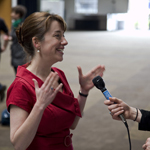

It’s no longer enough for researchers to simply publish their findings. To have a real world impact on an issue like tobacco control, researchers need to work in partnership with policy makers, experts and the community, says 45 and Up Study Director Professor Emily Banks.
The great German writer and statesman Johann Wolfgang von Goethe once wrote that “thinking is easy, acting is difficult, and to put one’s thoughts into action is the most difficult thing in the world”. Blue-sky research (that conducted without a clear goal) is important, but I’ve always been driven by the idea that research should make a difference in the real world.
Too much excellent research languishes on dusty shelves or behind paywalls in journals only researchers read. It is not just the politics of an issue or the lack of funding to implement a policy that prevents research from seeing the light of day (although both of these can be challenges). Too often, the right research is not getting into the right hands at the right time to make a difference. To make an impact, researchers must dedicate the same degree of intellect, rigor and passion to the translation of their research findings into policy outcomes as they do to generating their findings.
That’s why I was so excited by the recent Excise Tariff Amendment (tobacco) Bill 2016. I’ll be the first to admit that even for a research scientist who spends most of her days in large-scale statistical models these amendments can often be dense, impenetrable and, well, dull. But, one of the core justifications put forward by the government to increase the excise on tobacco was the research we conducted demonstrating the true health impact of long-term tobacco smoking on Australians.
What we don’t know can hurt us
When governments make substantive policy decisions they should rely on many sources of information. Hard data relevant to the issue and their citizens is a key part of the picture. Intervention without the appropriate research and evaluation is a potential health hazard. The trauma and devastation caused by thalidomide prescription to pregnant women in the 1950s and 60s is a prime example of a perfect storm: clinical intervention based on inadequate research and under-developed evidence-based regulatory mechanisms in place to protect patients.
A lack of intervention or oversight, such as the many decades of asbestos building and mining, can be equally devastating. Policy makers need to know the risks of action versus inaction, so they can weigh the costs of intervention. This is what we set out to do with the first large-scale direct evidence on the effect of smoking on death rates in Australia.
What we didn’t know about smoking
While it’s hardly breaking news that smoking is bad for you, there has been a dearth of contemporary Australian evidence on the health impacts of long-term smoking. Smoking remains the largest readily preventable cause of death and disease in Australia. Globally it is a growing epidemic. There were an estimated 100 million deaths globally from smoking in the 20th century; it is estimated that there will be one billion in the 21st century if we continue on our current course.
The risks of tobacco vary from country to country and evolve over time. In the 1960s, relatively early on in the tobacco epidemic, international research had shown that risk to your health from smoking was akin to rolling a dice; you had a one in six chance of dying prematurely as a result of your smoking. By the 1980s, with longer-term and heavier smoking, the risks of smoking had evolved; your chance of dying from your habit was 50/50: more like flipping a coin. Our 2015 research, based on data from more than 200,000 Australians participating in the largest long-term study of ageing in the Southern Hemisphere (the Sax Institute’s 45 and Up study), found that the odds were even bleaker.
To extend the gambling analogy even further, long-term smoking is like playing blackjack in a crooked casino; up to two times out of three you lose. Around 1.8 million of the 2.7 million Australians who currently smoke will die because of their habit if they don’t quit. This was the first large-scale, direct evidence on smoking and mortality in Australia.
The co-production model
Among the most effective ways for research to have the best chance of making a real impact is for researchers to work in partnership with experts and agencies, what is often termed a “co-production” model. We partnered with the Cancer Council and the Heart Foundation from the beginning of this research project. Not only are they experts in this area, they are experts in policy and in making a difference at a community level.
Working together with tobacco control experts, we successfully used these findings to drive real change, by ensuring that they were in a form that could be used by both policy makers and the general public. These new findings have become embedded in the government’s policy on smoking, including the excise tariff amendment, which will progressively raise the price of tobacco by 12.5% each year over the next four years. Tobacco divestment campaigners such as Dr Bronwyn King have used these findings in advocacy. Smoking cessation organisations such as the Quitline are using these findings successfully in their front line services. I am frequently approached by people trying to quit who have said they have given them the evidence they need to stop smoking for good. In short, this is research making a real difference.
This article was first published on The Mandarin. Professor Emily Banks is the Scientific Director of the Sax Institute’s 45 and Up Study and Professor of Epidemiology and Public Health at the Australian National University
Find out more
- Read about how Professor Banks’ tobacco research has informed tobacco control
- Find out more about the 45 and Up Study





